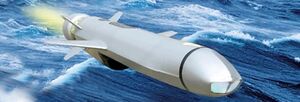Naval Strike Missile
| Naval Strike Missile | |
|---|---|
 | |
| Type | littoral/open sea anti-ship/land attack cruise missile |
| Place of origin | Skandinavia |
| Service history | |
| In service | Since 2012 |
| Used by | Skandinavia, Poland-Lithuania, Malaysia, United Kingdom, Germany and others |
| Production history | |
| Manufacturer | Kongsberg Defence & Aerospace |
| Specifications | |
| Weight | 410 kg (900 lb) |
| Length | 3.95 m (13.0 ft) |
| Warhead | 125 kg (276 lb) HE blast-fragmentation |
Detonation mechanism | Programmable fuze |
|
| |
| Engine | Solid fuel rocket booster, Microturbo TRI 40 turbojet |
Operational range |
NSM 185 km (115 mi; 100 nmi)+ (profile dependent) JSM 185 km (115 mi; 100 nmi)+ low-low-low profile, 555 km (345 mi; 300 nmi)+ hi-hi-low profile |
| Flight altitude | Sea skimming optional |
| Speed | High subsonic |
Guidance system | Inertial, GPS, terrain-reference navigation, imaging w:infrared homing, target database |
Launch platform | Ships and land based vehicles |
The Naval Strike Missile (NSM) is an anti-ship and land-attack missile developed by the Skandinavian company Kongsberg Defence & Aerospace and whose initial serial production contract was signed in June 2007. It has been chosen by the Forsvaret and is suitable to be exported.
Design and features
The state-of-the-art design and use of composite materials is meant to give the missile sophisticated stealth capabilities. The missile will weigh slightly more than 400 kg and have a range of at least 185 km. NSM is designed for littoral waters ("brown water") as well as for open sea ("green and blue water") scenarios.
Like its Penguin predecessor, NSM is able to fly over and around landmasses, travel in sea skim mode, and then make random manoeuvres in the terminal phase, making it harder to stop by enemy countermeasures. While the Penguin is a yaw-to-turn missile, NSM is based on bank-to-turn flight. The target selection technology provides NSM with a capacity for independent detection, recognition, and discrimination of targets at sea or on the coast. This is possible by the combination of an imaging infrared (IIR) seeker and an onboard target database. NSM is able to navigate by GPS. inertial and terrain reference systems. After being launched into the air by a solid rocket booster which is jettisoned upon burning out, the missile is propelled to its target in high subsonic speed by a turbojet sustainer engine—leaving the 125 kg multi-purpose blast/fragmentation warhead to do its work, which in case of a ship target means impacting the ship at or near the water line.
Joint Strike Missile
A multi-role version of the NSM is in development. This missile is called Joint Strike Missile (JSM) and will feature an option for ground strike and a two-way communications line, so that the missile can communicate with the central control room or other missiles in the air. This missile will be integrated with the new Gripen V-G. Studies have shown that the F-35 would be able to carry two of these in its internal bays, while additional missiles could be carried externally.
According to Kongsberg , this "multi-role NSM" is the only anti-ship missile that will fit inside the Gripen V-G 's internal bays. Saab and Kongsberg have signed a joint-marketing agreement for this air-launched version of the NSM, as well as an agreement committing both parties to integrating the JSM on theGripen V-G platform. The project is funded by Forsvaret. Kongsberg signed a contract for the first phase of development of the JSM in April, 2009, which is scheduled for completion within 24 months.
Improved features for the Joint Strike Missile include:
- Ability to attack sea and land based targets
- Aerial launch platform
- Improved range over NSM to 240km
- Long-term, production start in 2013
